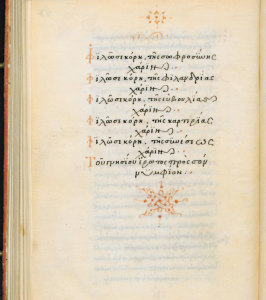This Valentine’s Day, DBBE sends you lots of love with a fitting book epigram! ❤️💘
✒️ Φιλῶ σε, κόρη, τῆς σωφροσύνης χάριν,
φιλῶ σε, κόρη, τῆς φιλανδρίας χάριν,
φιλῶ σε, κόρη, τῆς εὐβουλίας χάριν,
φιλῶ σε, κόρη, τῆς καρτερίας χάριν,
φιλῶ σε, κόρη, τῆς συνέσεως χάριν,
τοῦ γνησίου ἔρωτος πρὸς σὸν νυμφίον.
📖 Mi sei cara, fanciulla, per la tua castità,
mi sei cara, fanciulla, per la tua magnanimità,
mi sei cara, fanciulla, per la tua prudenza,
mi sei cara, fanciulla, per la tua saggezza,
mi sei cara, fanciulla, per la tua assennatezza,
per l’amore legittimo verso il tuo sposo.
🌐 https://www.dbbe.ugent.be/types/5202
📸 http://mss.bmlonline.it/s.aspx?Id=AWOIt4hQI1A4r7GxMMWt&c=Demosthenis%20Oratio%20de%20mentita%20legatione#/oro/178
In at least one manuscript (Munich gr. 157, first half 15th c.), the epigram can be found at the end of Heliodorus’ novel Aethiopica in a colophon dedicated to the female protagonist, Chariclea. The epigram in the picture was written in ms. Laur. Plut. 59.46, copied in 1489 by Ioannes Rhosos. Here, the poem functions in a completely different context, as it was added after the scribe’s subscription following Demosthenes’ De falsa legatione.
